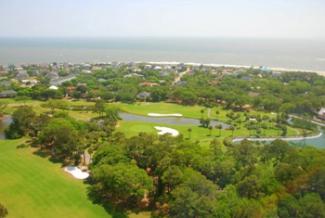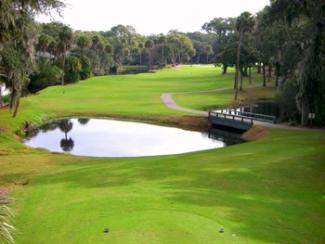Featured Golf News
A Hidden Gem in Carolina's Low Country
It's difficult to imagine that any course in the golf Mecca of South Carolina can still be a hidden gem. But that's what the owners and managers of The Plantation Course at Edisto Beach claim their charming layout to be.

Aerial View of Plantation Course at Edisto Beach
Tucked close by the ocean, about an hour's drive from the bustle of Charleston to the north and Hilton Head to the south, Edisto Beach remains one of the few areas that has not been overwhelmed by the tourist trade. You can still find peace and quiet here at rental condominiums and bungalows that dot the beach area of the little Low Country hamlet.
Once you leave busy Route 17 and head to Edisto Beach, you immediately enter another time as you drive past large live oaks draped with Spanish moss, stretches of open fields, and roadside stands. It's a scene right out of the 1950s or '60s.

10th hole of Plantation Course at Edisto Beach
"People feel this is a quiet, laid back alternative to Kiawah and Hilton Head," says Leland Vaughn, general manager of the club. "We like to think we know our clientele and we provide affordable golf and vacation rentals. We have had great reception from our players since we redid the course, and we will surpass our 2008 rounds played this year," which is saying something in this economy.
The club this year opened a new bar and four golf villas located close to the clubhouse to further accommodate visitors.
A Full Facelift
The owners of what was Edisto Beach Golf Club gave visitors another reason to visit the village when they pumped several million dollars into a renovation of what would become The Plantation Golf Course at Edisto Beach. The course had gotten a bit run down and needed a facelift. It was closed for 13 months to allow the upgrades and reopened three years ago.
Now, it's one of the sweetest tracks in the Low Country, with a linksy feel, plenty of water and a wonderful paspalum grass playing surface. With noted architect Tom Jackson completing the final stages of the course, the layout opened as the "Oristo" golf course in 1973. Sam Snead, Bob Goalby and Chuck Matlock played the first round on the track.
Not Long But Still Demanding
The par-70 Plantation Course at Edisto Beach is not long, only around 6,200 yards from the tips. But there is plenty of danger lurking, with water or wetlands on almost every hole, fairways that are somewhat narrow, and ample bunkering.
One of the best holes on the front side is the 371-yard par-4 fourth. It doglegs to the right and the fairway is very tight with trees guarding the right side and wetlands to the left. Big hitters can try and take it over the trees and shorten the hole. But there's OB if you wander too far right.
The sixth is a great little par-3, playing 162 yards with a full carry over water. And the eighth is a super-short par-4. It plays only 345 yards from the back and doglegs slightly left near the green. A pond guards the left side. No. 10 is a demanding, 438-yard par-4 that has water mostly all the way down the left side and a green protected by four bunkers.
The 14th, a 389-yard par-4, bends sharply left and demands a precise tee shot in order to hit a landing area that has water left and right. The 16th may be the toughest short hole on the course. The par-3 plays 184 yards from the tips and the green is surrounded by bunkers. The course ends with a solid par-5 that plays 525 yards from the back tees and can be reached in two by long-ballers.
A Paspalum Playing Surface
The Plantation Course at Edisto Beach is one of an increasing number of seaside courses that have grown in with or switched to paspalum grass. The owners settled on Sea Isle paspalum because of its ability to be irrigated by non-potable water sources.
"We are very near the ocean here and when I did soil samples before the renovation and took water analysis the bicarbonates and sodium levels were off the charts," says Vaughn. "We use effluent water to irrigate and we thought the paspalum was a good alternative to Bermuda. We really did our research, and we talked to turf growers and Dr. (Ron) Duncan at the University of Georgia (which has been at the forefront of seashore paspalum research and breeding since the 1990s). It's worked great for us. We have Sea Isle wall to wall and we were able to open our course three weeks earlier than if we had planted Bermuda grass."
To optimize his course conditions superintendent Tom Arneman treats his greens preventatively every 21 days with fungicides that include Insignia and Compass. "We rotate fungicides when the temperatures call for it. I've never put fungicide on the fairways, even though I get my fair share of dollar spot and brown patch. The grass will thin a little but the problem runs its course and the turf replenishes itself quickly.
"It seems to be a warm-weather grass with some cool season characteristics. You need to keep the paspalum at lower heights, but remember that paspalum likes to be brought down slowly. If you don't keep it low it will get clumpy on you. I've seen that in the rough areas."
Low mowing heights create the possibility of scalping the turf, and that can invite disease into the plant. Adds Arneman, "If you scuff it up it will recover slowly. That's why you have to have patience in bringing your mowing heights down. It is also advisable to verticut aggressively to prevent thatch and allow the tightly knit and deep paspalum roots to breathe and receive nourishment."
The conditioning efforts by Arneman, Vaughn and the rest of the staff seem to be working. If you're in Carolina's Low Country, be sure to stop by this course and see for yourself.
For further information, visit www.theplantationcourseatedisto.com.
This story originally appeared in Cybergolf on December 8, 2009.
John Torsiello is an editor/writer living in Connecticut. He has written extensively about all aspects of the golf industry for a number of national and regional publications. He is a regular contributor to Golf Course Industry, Lawn and Landscape, Golfing, and Fairway Living magazines as well as various online publications. He has strong, ongoing relationships with industry professionals and has worked closely with course owners, architects, developers, course superintendents and general managers around the country. He has won a number of awards for his writing, including first place from the Turf and Ornamental Communicators Association for a piece that appeared in Golf Course Industry magazine.
Story Options
 |
Print this Story |
